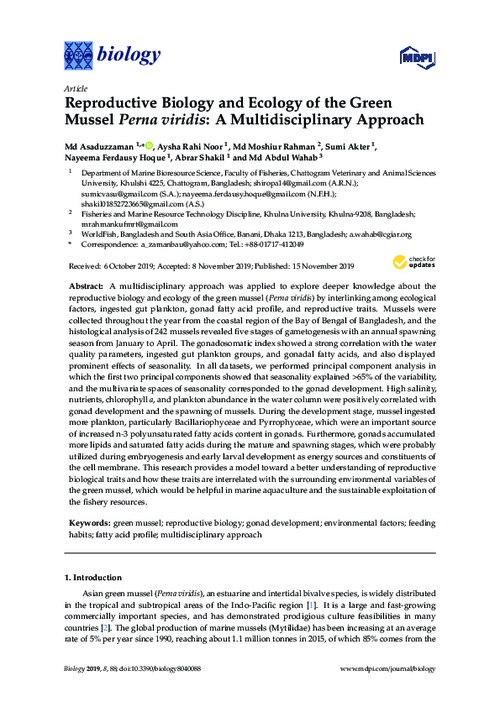Reproductive biology and ecology of the green mussel Perna viridis: A multidisciplinary approach

Citation
Asaduzzaman, M. et al. (2019). Reproductive biology and ecology of the green mussel Perna viridis: A multidisciplinary approach. Biology (Basel), 8(4): 88.
A multidisciplinary approach was applied to explore deeper knowledge about the reproductive biology and ecology of the green mussel (Perna viridis) by interlinking among ecological factors, ingested gut plankton, gonad fatty acid profile, and reproductive traits. Mussels were collected throughout the year from the coastal region of the Bay of Bengal of Bangladesh, and the histological analysis of 242 mussels revealed five stages of gametogenesis with an annual spawning season from January to April. The gonadosomatic index showed a strong correlation with the water quality parameters, ingested gut plankton groups, and gonadal fatty acids, and also displayed prominent e ects of seasonality. In all datasets, we performed principal component analysis in which the first two principal components showed that seasonality explained >65% of the variability, and the multivariate spaces of seasonality corresponded to the gonad development. High salinity, nutrients, chlorophyll a, and plankton abundance in the water column were positively correlated with gonad development and the spawning of mussels. During the development stage, mussel ingested more plankton, particularly Bacillariophyceae and Pyrrophyceae, which were an important source of increased n-3 polyunsaturated fatty acids content in gonads. Furthermore, gonads accumulated more lipids and saturated fatty acids during the mature and spawning stages, which were probably utilized during embryogenesis and early larval development as energy sources and constituents of the cell membrane. This research provides a model toward a better understanding of reproductive biological traits and how these traits are interrelated with the surrounding environmental variables of the green mussel, which would be helpful in marine aquaculture and the sustainable exploitation of the fishery resources.
Permalink
Date Available
Type
Countries
ISSN
2079-7737
Copyright
CC-BY-4.0
Research Themes
Language